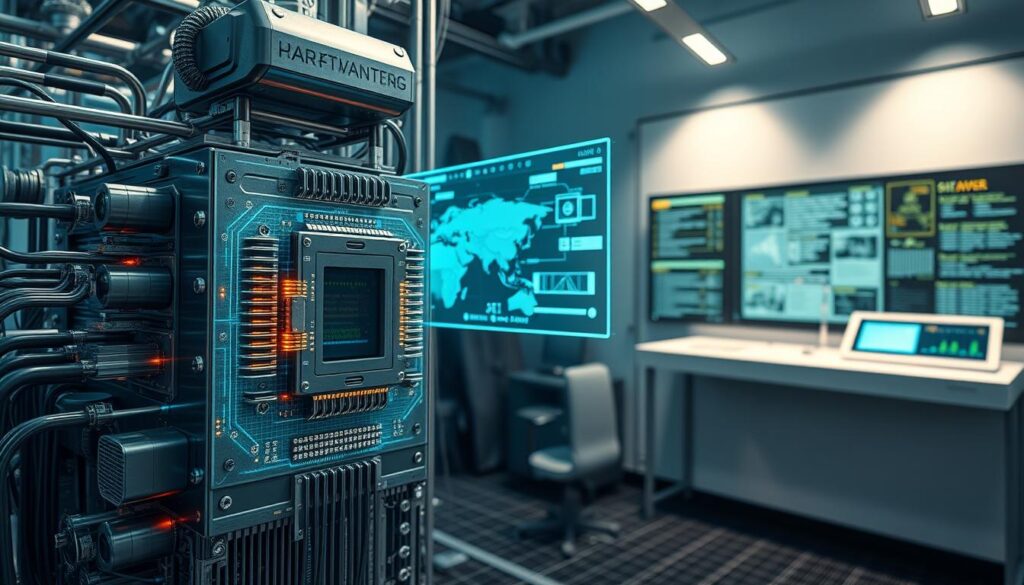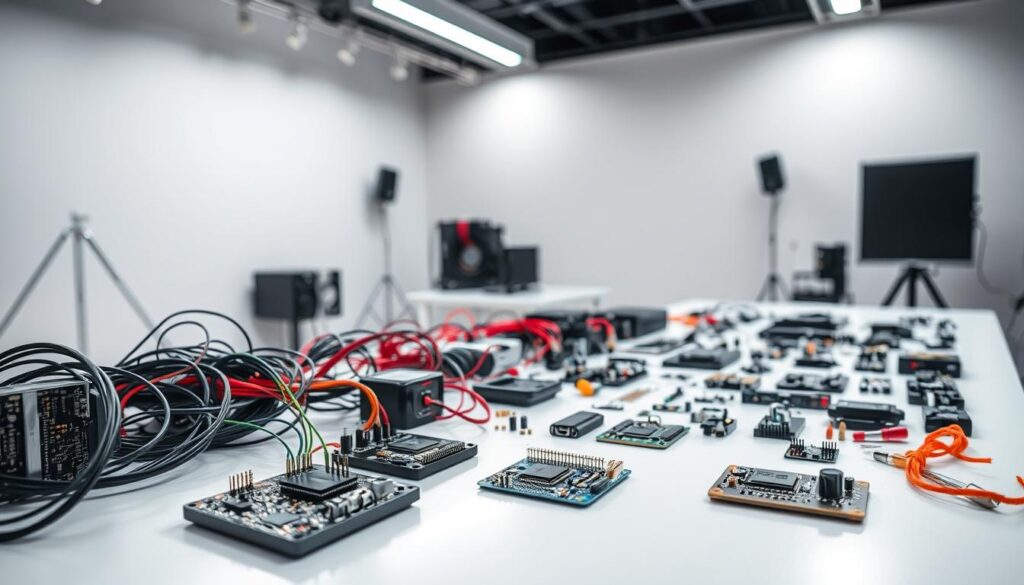Imagine your smartphone knowing what you want before you even ask. This isn’t just a dream—it’s real, thanks to ai neural networks. These networks are key to artificial intelligence and help solve problems we thought were too hard. But how do they work, and why should your business care?
Deep learning algorithms work faster than humans. They’re changing healthcare and finance by saving money and driving innovation. But, are they just a short-term trend, or a major tech breakthrough?
Key Takeaways
- ai neural networks are changing industries by solving tough problems.
- Learning about them opens up new chances in artificial intelligence.
- They make things like speech recognition and self-driving cars possible through deep learning.
- Companies that ignore these tools will fall behind their rivals.
- Getting started means understanding the basics, not just the tech terms.
Introduction to AI Neural Networks
Artificial intelligence (AI) and machine learning (ML) use neural networks to process data like our brains. These systems are key to cognitive computing. They power everything from voice assistants to self-driving cars. Let’s look at their beginnings, growth, and key terms.
What Are Neural Networks?
Neural networks are like the brain, with nodes connected in layers. Each layer helps recognize patterns in data. It’s like a web where data moves from input to output layers.
Important parts include:
- Nodes: Data-processing units
- Weights: Values adjusting node connections
- Activation functions: Rules deciding node output
History and Evolution of Neural Networks
The story started in 1943 with Warren McCulloch and Walter Pitts. They created brain-like circuits. By the 1980s, machine learning made them popular again.
Today, they power facial recognition and medical diagnostics. Modern advancements in cognitive computing have made them essential.
Key Terminology in Neural Networks
Learning these terms helps understand neural networks better:
Nodes are the basic units of computation. Layers group nodes for processing. Weights control how strong connections are, and biases affect when nodes activate.
Together, these elements help AI systems learn from data.
How AI Neural Networks Work
Neural networks work by mimicking the human brain’s pathways. They have layers that transform data. This process is called deep learning and helps with pattern recognition and machine learning.
The Structure of Neural Networks
Neural networks have three main parts: input, hidden, and output layers. The input layer gets raw data, like image pixels. Hidden layers process this data through math.
The output layer shows the results, like saying an image is a “cat” or “car.”
Activation Functions Explained
Activation functions tell when a neuron should fire. There are a few types:
- Sigmoid: Makes outputs smooth between 0 and 1
- ReLU: Uses a simple linear activation
- tanh: Works with -1 to 1 ranges for balanced outputs
Training Neural Networks: An Overview
Training teaches networks to get better. Here’s how:
- Feed data into the network
- Compare outputs to what they should be
- Adjust connections using gradient descent
- Keep doing this until they’re more accurate
Methods like backpropagation help make these adjustments. This way, networks can do things like spot patterns in medical scans or translate languages.
Types of Neural Networks
Neural networks are designed to tackle different challenges. By knowing their types, you can pick the right algorithm for your goals. Let’s dive into the main architectures and their uses in the real world.
Supervised vs. Unsupervised Learning
Supervised learning uses labeled data to predict outcomes. For instance, deep learning models trained on images can spot patterns in computer vision tasks. On the other hand, unsupervised learning finds hidden patterns in data without labels, like grouping customer preferences without categories.
Convolutional Neural Networks (CNNs)
CNNs are great at computer vision tasks. They look at spatial data, like edges and shapes in medical scans or for self-driving cars. CNNs have layers that process visual information, making them perfect for image and video analysis.
Recurrent Neural Networks (RNNs)
RNNs handle sequential data over time, which is key for natural language processing. They power chatbots, translate languages, and analyze stock trends. Special types like LSTMs deal with long-term data, enhancing text generation accuracy.
| Type | Key Use | Example |
|---|---|---|
| Supervised Learning | Image classification | Email spam detection |
| Unsupervised Learning | Data clustering | Customer segmentation |
| CNNs | Computer vision | Facial recognition systems |
| RNNs | Sequence analysis | Sentiment analysis tools |
Applications of AI Neural Networks

Neural networks are changing industries with real solutions. They can handle big data, leading to progress in healthcare, tech, and transport. They make daily tasks better.
Image and Speech Recognition
Computer vision systems look at pictures to find objects, faces, and places. Hospitals use them to spot tumors in scans. Apps like Google Photos sort photos on their own.
Speech recognition tools, like Amazon’s Alexa, understand voice commands. This lets us control smart homes with our voices.
- Facial recognition for security systems
- Medical imaging diagnostics
- Real-time translation in video calls
Natural Language Processing (NLP)
NLP connects humans and machines. Chatbots answer customer questions fast. Tools like OpenAI’s GPT-4 create content and check social media feelings.
This tech is behind email filters and language apps. It helps us communicate better.
“NLP has cut customer service response times by 40% for 60% of Fortune 500 companies.”
Autonomous Vehicles
Self-driving cars use pattern recognition to drive. Tesla’s Autopilot spots pedestrians and signs. Waymo plans routes as it goes.
These systems use camera and sensor data. They make sure the car drives safely.
Benefits of AI Neural Networks
AI neural networks bring big changes for businesses and researchers. They use artificial intelligence and data science to make data useful. Cognitive computing helps solve problems that were thought impossible, making things more efficient and innovative.
“Cognitive systems process data faster than traditional methods, enabling decisions that were impossible before.” — IBM Watson Research Team
Enhanced Data Processing Capabilities
Neural networks are great at handling huge amounts of data. In healthcare, they help analyze scans, improving diagnosis by 35%. Retailers use data science tools like TensorFlow to keep up with customer trends.
Improved Decision-Making
Cognitive computing helps make better choices. Banks spot fraud quickly, cutting losses by 40%. Manufacturers predict when equipment will fail, reducing downtime by 25%. These tools find patterns that humans miss.
Scalability and Flexibility
Scalable systems grow as you need them to. Cloud platforms like AWS let teams add power fast. Car companies use neural networks to adapt to new data, making it easy to keep up with new tech.
Challenges in AI Neural Networks
Creating effective ai neural networks faces technical and ethical challenges. As you delve into machine learning, knowing these hurdles is crucial for strong model development. Let’s look at the main issues in data science projects.
Overfitting and Underfitting Explained
Two big technical hurdles are overfitting and underfitting:
- Overfitting: Models learn the training data too well but fail with new data.
- Underfitting: Models are too simple and miss important details.
To fight overfitting, try:
- Regularization techniques.
- More diverse training data.
- Testing with cross-validation.
Data Privacy and Ethical Concerns
Using ai neural networks brings up privacy and ethics questions. Here are some key issues and how to solve them:
| Challenge | Solution |
|---|---|
| Data leakage risks | Use anonymization and encryption. |
| Algorithmic bias | Do regular audits and use diverse data. |
Following laws like GDPR is key. Make sure your machine learning is transparent to avoid legal and reputation problems.
The Future of AI Neural Networks
As artificial intelligence grows, neural networks are set to change many fields. New advancements in deep learning and cognitive computing are making machines smarter. They can now learn and solve complex problems faster. Here’s what we can look forward to.
Emerging Trends in Neural Network Research
Research is moving in three main directions:
- Neuromorphic chips that mimic the human brain
- Quantum neural networks for quicker data handling
- Self-supervised learning models that need less labeled data
The Role of AI in Industry 4.0
Industry 4.0 is all about using neural networks to change things. Here’s how:
| Application | Impact |
|---|---|
| Smart Manufacturing | Automated quality control systems |
| Supply Chains | Real-time demand forecasting |
| Healthcare | Personalized treatment recommendations |
Predictions for the Next Five Years
Experts predict big changes by 2030:
- Training times for deep learning models will drop by 50%
- AI systems will make decisions more transparently
- Tools like TensorFlow and PyTorch will be easier to use
- AI will work with IoT and blockchain for better data security
Even with challenges like data privacy, these advancements will make cognitive computing common in our lives. By 2030, neural networks might be as common as smartphones today.
Getting Started with AI Neural Networks

Start your journey into ai neural networks with the right tools and resources. Whether you’re coding your first model or exploring deep learning projects, these guides simplify the process.
Recommended Tools and Frameworks
Choose tools that fit your projects. Here are some top picks:
- TensorFlow: An open-source library for designing and deploying deep learning models.
- PyTorch: Great for research, with dynamic computation graphs for experimentation.
- Keras: A user-friendly API for quick prototyping of neural networks.
- AWS SageMaker & Google Cloud AI: Cloud platforms for scalable training and deployment.
Essential Resources for Beginners
Grow your knowledge with these curated resources:
- Online Courses: Try Coursera’s Deep Learning Specialization or fast.ai for hands-on projects.
- Books: Study “Deep Learning” by Ian Goodfellow or “Hands-On Machine Learning with Scikit-Learn” for foundational concepts.
- Communities: Join the TensorFlow Forum or explore GitHub repositories for code examples.
“The best way to learn is to do.” — Andrew Ng
Start with small projects like image classification or chatbots. Apply machine learning principles. Explore tutorials on platforms like Kaggle for real-world datasets. Begin today and grow your skills step by step.
Conclusion: The Vision Ahead
Advances in ai neural networks are changing many industries. They help in healthcare and finance by finding new insights. This technology opens doors to solving big problems and driving new ideas.
Build Your Expertise
Start by learning tools like TensorFlow or PyTorch. Try out ai neural networks. Use platforms like Kaggle to work on real data.
Join forums or meetups to meet experts in data science.
Apply Insights to Your Work
Look for ways to use ai neural networks in your field. They can make processes better or find new trends. These systems help solve today’s business challenges.
Stay Ahead of Innovations
Keep up with new discoveries by reading research journals and attending conferences. Online courses from Coursera or edX can help you learn more.
Look at how companies like NVIDIA use these technologies.
Shape the Future
Every field can use ai neural networks. Start small and grow your ideas. By learning these tools, you’ll lead the way in solving digital age problems.

